Abstract
BACKGROUND:
Electronic cigarette (E-cigarette) is an electronic nicotine delivery device that has been advocated as a safe alternative for cigarette smokers. Since the introduction of E-cigarette internationally and in the Kingdom of Saudi Arabia (KSA), it gained popularity, particularly among the youth and young adults. Moreover, many nonsmoker (nicotine-naïve) youth started to use E-cigarette as a new social habit. Recent researches have casted shadows on the E-cigarette safety profile.
OBJECTIVE:
The aim of this study is to assess the prevalence of E-cigarette use among students of health science colleges in Jeddah-KSA. It also assesses E-cigarette effectiveness as a smoking cessation method and its possible addictiveness.
METHODS:
The study is an epidemiological, cross-sectional study, which was conducted between November 2017 and December 2017 in three different universities in Jeddah. A self-administered online questionnaire related to E-cigarette and the conventional cigarette was used.
RESULTS:
A total of 1007 completed an electronic survey which was distributed to 3000 health sciences colleges' students. Of the participants 14.1% were cigarette smoker, 46% of them smoke regularly. Students who smoke half a pack per day and above were 22% of the smokers. More college students use the E-cigarette (27.7%). Moreover, one-fifth of the E-cigarettes users were using it on the regular daily basis. The study found that 42.7% of E-cigarettes users have used it as a tool to quit smoking. Interestingly, more than half (56.7%) of the students who used it to stop smoking has succeeded. However, only 46% of E-cigarettes users who tried to quit vaping have succeeded. Young aged, students believed that smoking is more addictive than vaping or recommended E-cigarette for smoking cessation found to have a higher chance of quitting smoking in the univariate regression analysis. While, in the multivariate analysis, students who believed that conventional smoking is more addictive than E-cigarettes; students started vaping to quit smoking, or used E-cigarettes with fruit flavor found to have significantly higher chance of quitting.
CONCLUSION:
The E-cigarettes vaping is more prevalent than conventional cigarette smoking among health sciences students in Jeddah-KSA. E-cigarettes are used as a tool to help smoking cessation in less than half of the user. E-cigarettes help some smokers to quit smoking. However, it seems as addictive to the users as conventional cigarette smoking.
Keywords: Conventional cigarettes, e-cigarettes, electronic cigarettes, medical students, smoking
Electronic cigarette (E-cigarette) is an electronic system that delivers nicotine in an aerosol form. It is composed of mouthpiece, atomizer, cartridge, and battery.[1] The cartridge is a reservoir which is filled by a fluid consisting of a mixture of propylene glycol, vegetable glycerin, nicotine, and flavors. The atomizer heats the liquid ingredients into vapor that are inhaled by the user.[1] E-cigarettes have gained popularity among youth and young adults due to the increased awareness of the conventional cigarettes hazards, health authorities' legislation, and restrictions on conventional cigarettes smoking in public places, continues focused marketing campaigns by the manufacturers and popular perception of E-cigarettes as a healthier alternative than conventional cigarette.
The prevalence of conventional cigarette smoking among health science students in Saudi Arabia has been reported in previous studies. It has been shown that around 13%[2,3] of the male and 2.4%[4] of the female medical students smoke a conventional cigarette. These percentages vary between the different geographic regions of the country. For instance, in the western region, it reaches 24.8% among males and 9.1% among females.[5] For other health science specialties, the prevalence of smoking is estimated to be 7.9%, 13.4%, and 29% for dental, pharmacy, and medical science students, respectively.[6,7,8] Less known about the E-cigarettes prevalence and pattern of use among health science students in Saudi Arabia as it has been recently introduced to the country. Experts have concerns that E-cigarettes are potentially addictive as they contain nicotine which has been proven to cause addiction.[9] In addition, the risks of long-term exposure to E-cigarettes vapors' chemicals which include potentially toxic substances such as formaldehyde have not been determined.[10] The impact of E-cigarettes on the human health is under intense investigations as there are no prolonged studies addressing this issue.[11]
The study is aimed to assess the prevalence of E-cigarette smoking in comparison to conventional smoking among health sciences university students in Jeddah and assesses its effectiveness as a smoking cessation method and its possible addictiveness.
Methods
Setting
This study is an epidemiological, cross-sectional study, which was conducted between November 2017 and December 2017, in three different universities in the city of Jeddah-the Kingdom of Saudi Arabia (KSA). All health science colleges' student from King Saud bin Abdulaziz University for Health Sciences, King Abdulaziz University, and Jeddah University were eligible. The survey was distributed to 3000 students from different colleges including medicine, applied medical sciences, nursing, and pharmacy.
Design
A self-administered online questionnaire composed of 18 questions related to E-cigarettes and conventional cigarettes was used. Participation in the study was voluntary and anonymous. Response data were obtained via (SurveyMonkey®). Participants were given a 4 weeks to complete the survey. The study protocol was reviewed and approved by the Institutional Review Board of the King Abdullah International Medical Research Center.
Instrument
An 18-item self-reported questionnaire related to E-cigarettes and conventional cigarettes was developed by the investigator team. The questionnaire content was validated by a specialist pulmonologist, whereas an expert methodologist validated its construction. The study reliability was carried out by conducting a pilot run of 15 participants. Cronbach's alpha for the 15 participants showed that Cronbach's alpha was at the level of 0.69, which considered acceptable for reliability analysis.
The questions were grouped into categories relating to sociodemographic data (age, gender, and specialty), cigarette smoking behavior (smoking status, frequency, and reasons of smoking) as well as E-cigarette related questions (flavors, personal motivation behind E-cigarette usage, addiction to and quitting trials of E-cigarette vaping). All participants provided general information about sociodemographic data and cigarette smoking habits if any. Only those familiar to E-cigarette were directed to questionnaire items to assess their use, knowledge, and perceptions.
Statistical analysis
Data collection, organization, and analysis are performed using Excel program (version16.0.8730.2046). Statistical analysis was performed using IBM SPSS(Version 24.0. Armonk, NY: IBM corp). The criterion for significance was set at P < 0.05.
Results
Baseline characteristics of the studied group
An electronic survey was distributed to 3000 students, 1007 students completed the survey. More than 75% of the participants aged between 19 and 22 years, the majority was female (66.2%). The baseline characteristics of the studied group are summarized in Table 1.
Table 1.
Baseline characteristics of the studied group
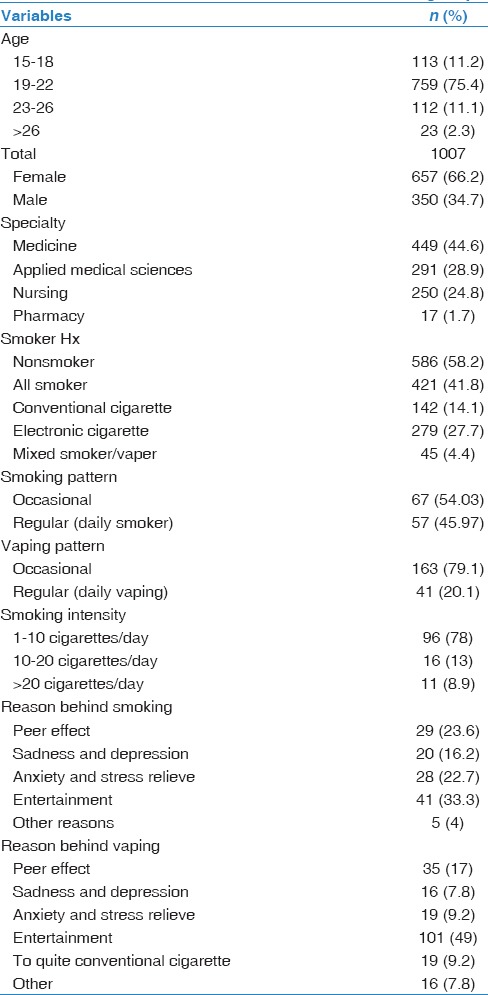
Prevalence and habits of electronic cigarette vaper and cigarette smoker
In our study, 142 college students (14.1%) were current cigarette smoker; 46% of them smoke regularly, i.e., daily cigarette smoker. Less than one-fourth of the smokers (22%) smoke half pack per day and above. Psychological stress specifically depression and anxiety were reported to be the main cause of smoking (38.9%). On the other hand, 27.7% of the students were using the E-cigarette, one-fifth (20.1%) of them were vaping on a daily basis. Most of the E-cigarette user used it for entertainment (49%); while, minority of the students used the E-cigarette due to depression (7.8%) and anxiety (9.2%). E-cigarettes are not yet prohibited in KSA from being used in cafes and restaurants, interestingly, 21.8% of e-cigarette users reported using it in places prohibiting conventional cigarette use [Table 2A and Figure 1].
Table 2.
Smoking and vaping related data
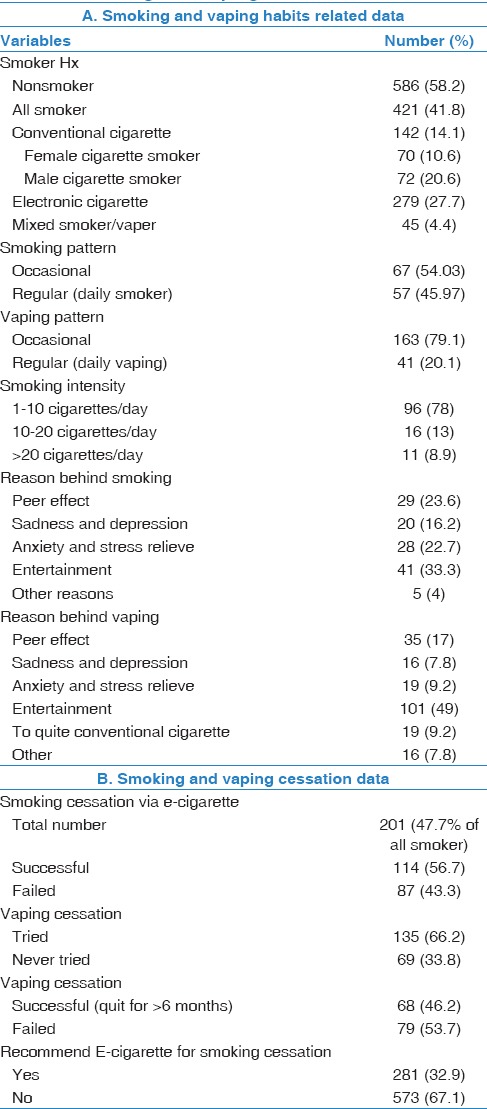
Figure 1.
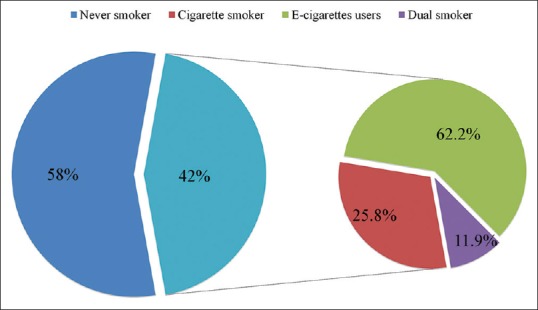
The percentages of nonsmokers, cigarette smokers and electronic cigarette users
Smoking and/or vaping cessation
The majority of the e-cigarette user 88 out of 206 (42.7%) started vaping as a method to quit conventional cigarette smoking. This was the sole reason for trying the e-cigarette in 9.2% of the user. Twelve students (5.8%) used e-cigarette after the failure of one or more smoking cessation methods. An impressive 56.7% reported of being successful in quitting smoking using E-cigarette. Almost two-third (66.2%) of the E-cigarette user have considered quitting all type of smoking and vaping. Less than half (46.2%) of those who tried to quit vaping managed to quit for equal to or more than 6 months [Table 2B and Figure 2].
Figure 2.
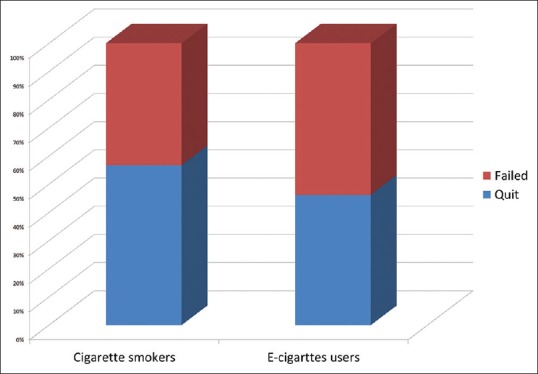
The success rate of quitting cigarette smoking and electronic cigarette vaping
In the univariate logistic regression analysis participants aged 19 years and less, students that recommended E-cigarette as a method to quit smoking or believed that conventional smoking is more addictive found to have statistically significant higher chance of smoking cessation. However, in the multivariate analysis, again students believed that conventional smoking is more addictive have statistically significant chance to quit smoking. In addition, students used E-cigarette for the reason of quitting and students who used E-cigarette with fruit flavor found to have significantly higher chance of quitting [Table 3].
Table 3.
Smoking cessation logistic regression table
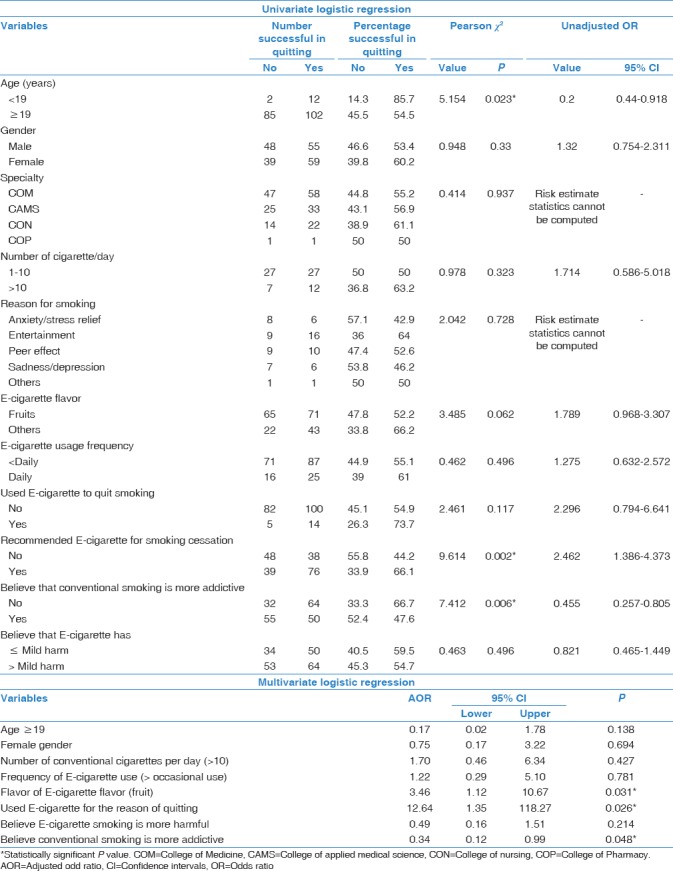
Perception of the electronic cigarette addictiveness
From 854 participants who answered the question of which habit they think is more addictive? Almost the half (49%) believed that both conventional cigarette and E-cigarette are equally addictive, whereas 7.85% believed E-cigarette is more addictive than the conventional cigarette.
Discussion
E-cigarette is an electronic nicotine delivery device which has been advocated as a safe alternative for cigarette smoker. Studies have shown that e-cigarette has no immediate effect on the cardiac and pulmonary function as measured by echocardiogram and lung functions tests.[12,13,14] However, it causes an increase in respiratory flow resistance and respiratory impedance.[15] In addition, it decreases fractional exhaled nitric oxide to the similar extent of conventional smoking.[15] More concern has been raised after a recent study shows that E-cigarette alters the profile of innate defense proteins in the airway uniquely and similar to cigarette smoking.[16] In a preliminary study at Danderyd University Hospital, Sweden there was a significant increase in heart rate and blood pressure in healthy volunteers who were exposed to E-cigarettes containing nicotine.[17] Recently, the World health organization considered E-cigarette a source of toxic fumes.[18] On the other hand, an expert committee in the united stat from the National Academies of Sciences, Engineering, and Medicine found conclusive evidence that substituting E-cigarettes for conventional tobacco cigarettes reduces users' exposure to numerous toxins and carcinogens. The report acknowledges that E-cigarette increases the nicotine concentration in indoor environments, emit potentially toxic substances and can deliver comparable nicotine dose to conventional cigarettes.[19]
The Forum of International Respiratory Societies recommends that E-cigarettes should be considered tobacco products and regulated as such. That implies prohibiting media advertising, flavorings, sale to adolescents and young adults, indoor and public places use.[4]
These concerns lead us to conduct the current epidemiological study to have a better understanding of the E-cigarette prevalence and perception among the health science students.
A total of 1007 students from four different colleges (college of Medicine, College of applied medical science, college of nursing and college of Pharmacy) in the city of Jeddah-western region of KSA have participated in the study. The prevalence of cigarette smoking among the studied cohort is 14.1% (20.6% and 10.6% for male and female, respectively). This prevalence is comparable to the previously reported prevalence of 24.8% and 9.1% for male and female medical students, respectively, in the same geographic region of KSA.[4] E-cigarette has only recently become available in the Kingdome of Saudi Arabia; nevertheless, our study showed that it becomes a popular habit among young adult's students. The prevalence of E-cigarette user was 27.7%; which is almost twice as much as conventional cigarette smoker. A similar percentage (25.6%) was reported from King Saud University's students in Riyadh.[20] Higher prevalence of 33.5% has been reported in a general survey conducted by Al Baik et al.[21] We believed that the reason behind this rapidly gaining popularity of the E-cigarette is the use of wide-scale advertising campaign targeting the youth and young adult, in a similar fashion used by conventional cigarette smoker.[22,23] The prevalence reported in our study is significantly higher than what has been reported among medical students in Poland; however, close to prevalence in the United States of America where the prevalence was 3.5% and 24.2% consecutively.[24,25]
The increasing popularity of E-cigarette is related to multiple factors that may vary among different populations. Half of E-cigarette user in our cohort used it for entertainment. Similarly, using conventional cigarette for entertainment was the main reason of smoking in 33.3% of the students. The effect of the student's peer to try a new product is the second most common case for using both types of smoking. In our study, 42.7% of the user considered it as a tool for smoking cessation; Only 9.2% reported that quitting smoking was the sole reason to start using E-cigarette. A 5.8% of the E-cigarette users have considered it after the failure of one or more smoking cessation methods. In the central region of the country, the percentage of students used E-cigarette to quit smoking was 24.3%.[20] International data shows that 58.7% of polish students tried E-cigarette in an attempt to quit conventional smoking.[24] Between 4.1% and 23.1% of the American universities' students who used E-cigarette used it for this reason.[25,26] An impressive 56.7% success rate of quitting smoking using E-cigarette recorded in our study. This high percentage might be explained by the low cumulative smoking history of the studied cohort and hence less addiction to the smoking habit. The reasons behind this were as follows: first, the relatively young age of the studied group. Second, 54% of the conventional cigarette smokers were occasional smoker only. Third, 78% of the smokers do smoke less than half pack/day. A Cochrane review included 24 studies with a combined sample size of 662 participants support the usefulness of E-cigarette in smoking cessation. It showed that E-cigarette users were more likely to quit smoking for at least 6 months compared to placebo (RR = 2.29).[27] On the other hand, researchers have a concern that E-cigarette itself could be a gateway for nonsmokers to initiate conventional cigarettes smoking,[28] we could not deduct a conclusion in this point from our cross-sectional survey. We found that students used E-cigarette for the reason of quitting and students who used E-cigarette with fruit flavor have had significantly higher chance of quitting in multivariate regression analysis. Students believed that conventional smoking is more addictive found to have statistically significant higher chance to quit smoking as well.
With regard to smoking and vaping habit perception, about 37% of E-cigarette users in our study believed that E-cigarettes are less harmful than conventional smoking. Moreover, 15% consider E-cigarette safe. Almost 2/3 (66.2%) of the E-cigarette user have considered quitting all types of smoking and vaping. On questioning the students on their perception of the addictiveness of the E-cigarette, almost the half (49%) of the participants believed that both conventional cigarette and E-cigarette are equally addictive, while, minority (7.85%) believed it is more addictive than the conventional smoking. Despite this belief, less than half (46.2%) of those who tried to quit vaping managed to quit for equal to or more than 6 months. It has been shown that 19% of middle school students in Mexico believe that E-cigarettes were less harmful than conventional cigarettes and 10% had tried them.[29] The same perception was found in a study of general population in the United Kingdom. In the study, 67% believed that E-cigarettes are less harmful than conventional cigarettes.[30]
Limitations
We acknowledge that our study is restricted to the specific population of the high level of education and confined to one geographical area, which limits the generalizability of our results to the general population of Saudi Arabia. Second, our data are self-reported and subject to recall and social desirability biases. A larger study that represents the general population of Saudi Arabia warranted.
Conclusion
The following points can be concluded from the study. First, E-cigarette users among the health sciences students in Jeddah are almost double the cigarette smoker; however, more cigarette smoker do smoke on a regular base. Secondary, E-cigarette might help smoker, especially occasional, light smoker (who smoke half pack/day or less); however, itself is addictive habit. Finally, a group of dual cigarette user (electronic and regular) has been highlighted in this study.
Recommendations
For further studies, we suggest considering more regions of Saudi Arabia to generalize the entire population. Clinical studies that explore E-cigarette effect on the lung function and radiology are also needed.
Financial support and sponsorship
Nil.
Conflicts of interest
There are no conflicts of interest.
References
- 1.Vaporizers, E-Cigarettes, and other Electronic Nicotine Delivery Systems (ENDS) Fda.gov. 2017. [Last accessed on 2017 Apr 06]. Available from: https://www.fda.gov/tobaccoproducts/labeling/productsingredientscomponents/ucm456610.htm .
- 2.Al-Turki YA. Smoking habits among medical students in central Saudi Arabia. Saudi Med J. 2006;27:700–3. [PubMed] [Google Scholar]
- 3.Abolfotouh MA, Abdel Aziz M, Alakija W, Al-Safy A, Khattab MS, Mirdad S, et al. Smoking habits of king Saud university students in Abha, Saudi Arabia. Ann Saudi Med. 1998;18:212–6. doi: 10.5144/0256-4947.1998.212. [DOI] [PubMed] [Google Scholar]
- 4.Al-Turki YA, Al-Rowais NA. Prevalence of smoking among female medical students in the college of medicine, Riyadh, Saudi Arabia. Saudi Med J. 2008;29:311–2. [PubMed] [Google Scholar]
- 5.Wali SO. Smoking habits among medical students in Western Saudi Arabia. Saudi Med J. 2011;32:843–8. [PubMed] [Google Scholar]
- 6.Almas K, Al-Hawish A, Al-Khamis W. Oral hygiene practices, smoking habit, and self-perceived oral malodor among dental students. J Contemp Dent Pract. 2003;4:77–90. [PubMed] [Google Scholar]
- 7.Al-Arifi MN. Smoking habits among pharmacy students at a university in central Saudi Arabia. Saudi Med J. 2005;26:893–5. [PubMed] [Google Scholar]
- 8.Hasim TJ. Smoking habits of students in college of applied medical science, Saudi Arabia. Saudi Med J. 2000;21:76–80. [PubMed] [Google Scholar]
- 9.Ferkol TW, Farber HJ, La Grutta S, Leone FT, Marshall HM, Neptune E, et al. Electronic cigarette use in youths: A position statement of the forum of international respiratory societies. Eur Respir J 2018;51. 2018;51:pii: 1800278. doi: 10.1183/13993003.00278-2018. [DOI] [PubMed] [Google Scholar]
- 10.Jensen RP, Luo W, Pankow JF, Strongin RM, Peyton DH. Hidden formaldehyde in e-cigarette aerosols. N Engl J Med. 2015;372:392–4. doi: 10.1056/NEJMc1413069. [DOI] [PubMed] [Google Scholar]
- 11.Callahan-Lyon P. Electronic cigarettes: Human health effects. Tob Control. 2014;23(Suppl 2):ii36–40. doi: 10.1136/tobaccocontrol-2013-051470. [DOI] [PMC free article] [PubMed] [Google Scholar]
- 12.Chorti M, Poulianiti K, Jamurtas A, Kostikas K, Tzatzarakis M, Vynias D, et al. Effects of active and passive electronic and tobacco cigarette smoking on lung function. Toxicol Lett. 2012;211:S64. [Google Scholar]
- 13.Flouris AD, Chorti MS, Poulianiti KP, Jamurtas AZ, Kostikas K, Tzatzarakis MN, et al. Acute impact of active and passive electronic cigarette smoking on serum cotinine and lung function. Inhal Toxicol. 2013;25:91–101. doi: 10.3109/08958378.2012.758197. [DOI] [PubMed] [Google Scholar]
- 14.Farsalinos KE, Tsiapras D, Kyrzopoulos S, Savvopoulou M, Voudris V. Acute effects of using an electronic nicotine-delivery device (electronic cigarette) on myocardial function: Comparison with the effects of regular cigarettes. BMC Cardiovasc Disord. 2014;14:78. doi: 10.1186/1471-2261-14-78. [DOI] [PMC free article] [PubMed] [Google Scholar]
- 15.Vardavas CI, Anagnostopoulos N, Kougias M, Evangelopoulou V, Connolly GN, Behrakis PK. Short-term pulmonary effects of using an electronic cigarette: Impact on respiratory flow resistance, impedance, and exhaled nitric oxide. Chest. 2012;141:1400–6. doi: 10.1378/chest.11-2443. [DOI] [PubMed] [Google Scholar]
- 16.Reidel B, Radicioni G, Clapp PW, Ford AA, Abdelwahab S, Rebuli ME, et al. E-cigarette use causes a unique innate immune response in the lung, involving increased neutrophilic activation and altered mucin secretion. Am J Respir Crit Care Med. 2018;197:492–501. doi: 10.1164/rccm.201708-1590OC. [DOI] [PMC free article] [PubMed] [Google Scholar]
- 17. [Last accessed on 2015 Jun 14]. Available from: https://www.ersnet.org/the-society/news/e-cigarettes-linked-to-increased-arterial-stiffness,-blood-pressure-and-heart-rate-in-humans .
- 18.WHO | Marketers of Electronic Cigarettes should Halt Unproved Therapy Claims. 2017. [Last accessed on 2017 Dec 24]. Available from: http://www.who.int/mediacentre/news/releases/2008/pr34/en/
- 19.National Academies of Sciences, Engineering and Medicine. Committee on the Review of the Health Effects of Electronic Nicotine Delivery Systems. Consensus Report. Environmental Health, Public Health, Substance Use and Mental Health. 2018. Jan, [Last accessed in 2018 Jun 14]. Available from: http://www.nationalacademies.org/hmd/Reports/2018/public-health-consequences-of-e-cigarettes.aspx .
- 20.Awan KH. Experimentation and correlates of electronic nicotine delivery system (electronic cigarettes) among university students – A cross sectional study. Saudi Dent J. 2016;28:91–5. doi: 10.1016/j.sdentj.2015.12.002. [DOI] [PMC free article] [PubMed] [Google Scholar]
- 21.Al Baik M, Abdrabulnabi A, Aldahan S, Alkhadhrawi N. Electronic cigarette in Saudi Arabia: An online survey. Valley Int J. 2014;1:411–26. [Google Scholar]
- 22.Pierce JP, Messer K, James LE, White MM, Kealey S, Vallone DM, et al. Camel no.9 cigarette-marketing campaign targeted young teenage girls. Pediatrics. 2010;125:619–26. doi: 10.1542/peds.2009-0607. [DOI] [PubMed] [Google Scholar]
- 23.Singh T, Agaku IT, Arrazola RA, Marynak KL, Neff LJ, Rolle IT, et al. Exposure to advertisements and electronic cigarette use among US middle and high school students. Pediatrics. 2016;137:pii: e20154155. doi: 10.1542/peds.2015-4155. [DOI] [PMC free article] [PubMed] [Google Scholar]
- 24.Brożek G, Jankowski M, Zejda J, Jarosińska A, Idzik A, Bańka P, et al. E-smoking among students of medicine – Frequency, pattern and motivations. Adv Respir Med. 2017;85:8–14. doi: 10.5603/ARM.2017.0003. [DOI] [PubMed] [Google Scholar]
- 25.Franks AM, Hawes WA, McCain KR, Payakachat N. Electronic cigarette use, knowledge, and perceptions among health professional students. Curr Pharm Teach Learn. 2017;9:1003–9. doi: 10.1016/j.cptl.2017.07.023. [DOI] [PubMed] [Google Scholar]
- 26.Zhou S, Van Devanter N, Fenstermaker M, Cawkwell P, Sherman S, Weitzman M, et al. A study of the use, knowledge, and beliefs about cigarettes and alternative tobacco products among students at one U.S. medical school. Acad Med. 2015;90:1713–9. doi: 10.1097/ACM.0000000000000873. [DOI] [PMC free article] [PubMed] [Google Scholar]
- 27.McRobbie H, Bullen C, Hartmann-Boyce J, Hajek P. Electronic cigarettes for smoking cessation and reduction. Cochrane Database Syst Rev. 2014;12:CD010216. doi: 10.1002/14651858.CD010216.pub2. doi: 10.1002/14651858.CD010216.pub2. Epub 2014 Dec 17. [DOI] [PubMed] [Google Scholar]
- 28.Grana RA. Electronic cigarettes: A new nicotine gateway? J Adolesc Health. 2013;52:135–6. doi: 10.1016/j.jadohealth.2012.11.007. [DOI] [PubMed] [Google Scholar]
- 29.Thrasher JF, Abad-Vivero EN, Barrientos-Gutíerrez I, Pérez-Hernández R, Reynales-Shigematsu LM, Mejía R, et al. Prevalence and correlates of E-cigarette perceptions and trial among early adolescents in Mexico. J Adolesc Health. 2016;58:358–65. doi: 10.1016/j.jadohealth.2015.11.008. [DOI] [PMC free article] [PubMed] [Google Scholar]
- 30.Brown J, West R, Beard E, Michie S, Shahab L, McNeill A, et al. Prevalence and characteristics of e-cigarette users in Great Britain: Findings from a general population survey of smokers. Addict Behav. 2014;39:1120–5. doi: 10.1016/j.addbeh.2014.03.009. [DOI] [PMC free article] [PubMed] [Google Scholar]


